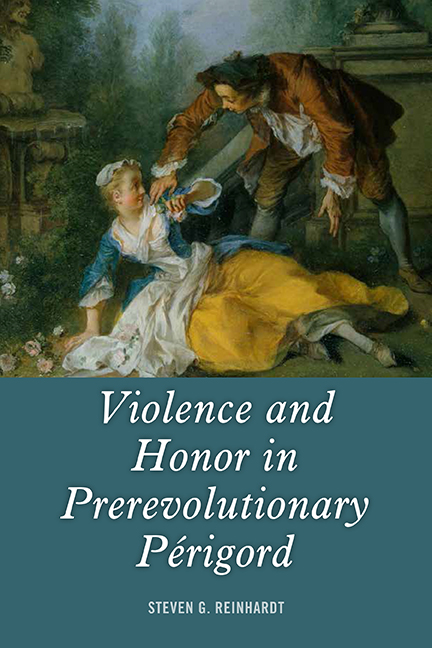Book contents
- Frontmatter
- Dedication
- Contents
- Acknowledgments
- Maps
- Introduction: “The Saint of Honor”
- 1 Violence and Honor
- 2 Honor in a Cross-Cultural Context
- 3 From Honor to Honnêteté in Old Regime Europe
- 4 “The Good Old Days” in Prerevolutionary Sarladais
- 5 “The Saint of Honor” in the Sénéchaussée of Sarlat
- 6 Women and Honor-Related Criminal Affaires
- 7 Policing Honnêteté: Shameful, Sinful, and Criminal Conduct
- 8 “Fallen Women” and Infanticide
- 9 Compromised Honor and Dangerous Liaisons
- 10 Honor and Homicide
- Conclusion
- Notes
- Bibliography
- Index
4 - “The Good Old Days” in Prerevolutionary Sarladais
Published online by Cambridge University Press: 10 June 2021
- Frontmatter
- Dedication
- Contents
- Acknowledgments
- Maps
- Introduction: “The Saint of Honor”
- 1 Violence and Honor
- 2 Honor in a Cross-Cultural Context
- 3 From Honor to Honnêteté in Old Regime Europe
- 4 “The Good Old Days” in Prerevolutionary Sarladais
- 5 “The Saint of Honor” in the Sénéchaussée of Sarlat
- 6 Women and Honor-Related Criminal Affaires
- 7 Policing Honnêteté: Shameful, Sinful, and Criminal Conduct
- 8 “Fallen Women” and Infanticide
- 9 Compromised Honor and Dangerous Liaisons
- 10 Honor and Homicide
- Conclusion
- Notes
- Bibliography
- Index
Summary
In 1778, when François-de-Paule Latapie, inspector of manufactures, toured the Périgord, he remarked on the persistence of the populace's traditional moeurs in comparison to elsewhere in Aquitaine. What particularly distressed him was the scarcity of elite men who had shed their “antiquated moeurs”:
We regret what we call “the good old days” and I have never quite known why. The less civilized man is more merciless. It seems to me that man is gentler and more indulgent the further he distances himself from his primitive state of savagery. The men who appear to me to combine the most social virtues are the good noblemen or well-off bourgeois who, having received an éducation honnête, have chosen to settle on their lands or in their villages, where they spend their revenue. This is the class that is probably the most useful and the most respectable of a State.
Shunning luxury and fashion, such men instead conformed to the laws of nature and led lives that were truly human, argued Latapie. Only these enlightened and civilized individuals would be able to “revivify their locales and remedy indigence without even trying.”
A pan-European code of honor (differentiated by gender) was shared by elites and the populace throughout Europe during the early modern period. The thirteenth-century Castilian legal code, for example, distinguished by gender different kinds of verbal insults: “Women are insulted or outraged by … making lewd proposals to them… . A man may be insulted by a deed, by a kick, by a blow of the hand, stick, or stone, by pursuit with intent to wound, by tearing his clothes or by deliberate damage to his house or property.” As much seems to have applied to the inhabitants of medieval Castile, the artisans of sixteenthcentury Dijon, or the peasants of the late eighteenth-century Sarladais. Honor was traditionally demonstrated by showing deference to others and acknowledging precedence shown toward oneself. These found oral expression in forms of address and physical expression in gestures generally associated with the head—which may be bowed, touched, covered, or uncovered.
- Type
- Chapter
- Information
- Violence and Honor in Prerevolutionary Périgord , pp. 71 - 94Publisher: Boydell & BrewerPrint publication year: 2018

